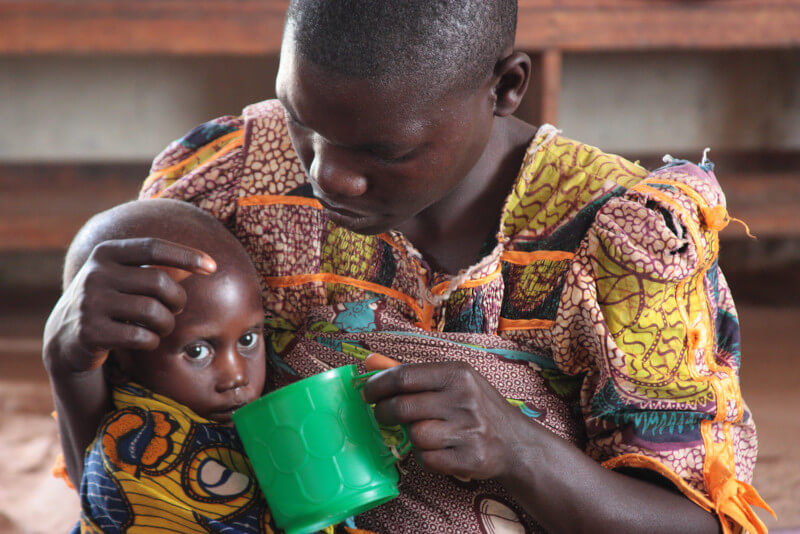In many regions faced with hunger, we often witness the harrowing image of an emaciated child, with a distinctly large belly. This swollen belly is a telltale sign of kwashiorkor, a severe form of malnutrition.
Understanding Kwashiorkor
Kwashiorkor is marked more than just by an enlarged abdomen. Those afflicted show symptoms ranging from swelling of feet and ankles to hair thinning, loss of skin pigmentation, irritability, and even tooth loss. One of the internal consequences is an enlarged fatty liver. The weakened abdominal muscles in combination with a compromised lymphatic system lead to a build-up of liquid wastes, resulting in the characteristic bloated belly.
More severe effects include painful skin lesions resembling burns, increased susceptibility to infections, and common ailments like diarrhea and worm infestations. If left untreated, children can slip into a coma and may eventually die.
The Root of the Problem
Traditionally, kwashiorkor has been linked to protein deficiency. However, recent studies in Uganda have questioned this, finding no direct correlation between dietary protein and kwashiorkor incidence. There’s a growing belief that the ailment may be due to a complex interplay of factors – ranging from deficiency in vital nutrients like vitamins A and E to external factors like aflatoxin from moldy food and rampant diseases.
Children from impoverished backgrounds, living in overcrowded and unsanitary conditions, stand at the highest risk of contracting kwashiorkor. Diarrhea, severe infections, and inadequate food storage conditions, conducive to mold growth, further exacerbate the risk.
A Path to Recovery
Treatment begins with hydration, followed by antibiotics and deworming. It’s vital to reintroduce protein to kwashiorkor patients cautiously since an overloaded liver can lead to life-threatening complications. Initially, milk products are minimized, gradually introducing the necessary protein to their diet. Soy milk serves as a helpful alternative for lactose-intolerant children. Alongside, essential vitamins and minerals are supplemented.
On a broader scale, the key lies in ensuring clean water, sanitation, proper housing, and food storage to prevent mold growth. Yet, many kids, particularly those below seven months, even if treated, may suffer long-term cognitive and physical growth impacts.
A Global Challenge
The stark reality, as highlighted by UNICEF, is that a child under five dies from starvation every 3.6 seconds. A significant portion of the global child population struggles daily with chronic malnourishment. A lack of sanitation and clean drinking water further compounds the problem, resulting in the daily loss of thousands of young lives.
Even countries like the USA aren’t immune. A substantial number of American children grapple with food insecurity, and despite assistance programs like the National School Lunch Program and SNAP, challenges persist. Budget cuts and rising food costs only add to the struggle of ensuring every child gets a nutritious meal.
Malnutrition, particularly in the context of infants and children, is a major global concern. Here are key statistics, focusing primarily on the South African context and broadening the scope to underline the severity of the issue:
- Prevalence of Stunting: According to the South African National Health and Nutrition Examination Survey (SANHANES), stunting (a chronic form of malnutrition) affected approximately 27% of South African children under the age of 5 as of 2013. Stunting is an indication of chronic undernutrition and can have long-term effects on a child’s growth and cognitive development.
- Micronutrient Deficiency: Iron deficiency anemia is a significant concern. A study from the South African Medical Research Council (SAMRC) revealed that 11% of children aged 1-5 years were found to be anemic. Anemia, especially when linked to iron deficiency, affects a child’s cognitive and physical development.
- Breastfeeding Rates: Exclusive breastfeeding for the first six months of life is recommended by the World Health Organization as a key intervention to prevent child malnutrition. However, data from Stats SA (Statistics South Africa) show that only about 32% of South African infants under 6 months were exclusively breastfed in 2016. This figure is low compared to the global target of achieving at least 50% by 2025.
- Child Mortality Rates: Undernutrition contributes to nearly half of all deaths in children under 5, and is widespread in Asia and Africa. In South Africa, the under-five mortality rate was around 37 deaths per 1,000 live births in 2019, with a significant portion linked to malnutrition and its associated complications.
- Impact of HIV on Malnutrition: South Africa has one of the highest HIV prevalences globally. Children born to HIV-infected mothers have a higher risk of being undernourished. According to UNAIDS data, approximately 320,000 children aged 0-14 were living with HIV in South Africa in 2019. The interaction between HIV and malnutrition is a complex one, with each exacerbating the effects of the other.
Join the Fight Against Malnutrition
Educate Yourself and Others
First and foremost, knowledge is power. Understanding the root causes and impacts of malnutrition positions you to make a difference. Share this knowledge within your community, school, or workplace. The more people are aware, the greater the collective effort.
Support Responsible Charities
Many reputable organizations are working tirelessly to combat global malnutrition. Consider donating to or volunteering with groups such as UNICEF, Save the Children, or Action Against Hunger. Your support can provide essential food, clean water, and medical care to those in need.
Adopt a Balanced Perspective on Food
In many developed nations, there’s an excess of food wastage. By being mindful of your consumption and waste, you not only save money but also reduce the strain on global food resources. Remember, every meal you save can potentially help feed someone in need.
Advocate for Change
Use your voice to lobby for policies that tackle malnutrition head-on. Write to your local representatives, emphasizing the importance of international aid and supporting policies that address food security. Your advocacy can drive change at a policy level.
Host Fundraising Events
Organize charity runs, bake sales, or garage sales with the proceeds going to anti-malnutrition initiatives. Not only will you raise funds, but you’ll also raise awareness within your community.
Stay Updated and Connected
Subscribe to newsletters or follow social media accounts of organizations tackling malnutrition. By staying updated, you’ll be in a position to support timely initiatives and campaigns.
Consider Global Impact When Shopping
When grocery shopping, try to buy products that are fair trade and sustainably sourced. This ensures that farmers in developing countries receive a fair price for their goods, reducing their risk of food insecurity.
FAQs on Making a Difference
Q: How much of my donation reaches those in need?
A: This varies by organization. Reputable charities usually allocate a significant percentage of donations directly to their cause. Always research before donating.
Q: Can I volunteer abroad to directly help malnourished communities?
A: Yes, many organizations offer volunteer programs. However, ensure you’re working with a recognized group to ensure your safety and that your efforts have a genuine impact.
Q: Apart from money, what else can I donate?
A: Some organizations accept non-monetary donations like food, clothing, and medicines. Check with the specific charity for their current needs.
Remember, every step you take, no matter how small, can make a significant difference in the fight against malnutrition. Your actions can save lives and offer a brighter future to many.
Understanding Hungry Infants’ Distended Bellies
The haunting image of an undernourished infant with an unnaturally enlarged belly isn’t merely a result of starvation – it’s the stark representation of a grave condition called kwashiorkor. This distressing malady is more than its visual manifestation; it represents a complex interplay of nutritional deficits and their impact on young bodies.
Kwashiorkor’s trademark bloated belly, while undeniably eye-catching, is only the tip of the iceberg. From telltale signs like tooth loss, pitting edema, and dermatitis to more sinister internal symptoms like fatty liver expansion, the disease paints a grim picture. The very core of this ailment traces back to weakened abdominal muscles and an overwhelmed lymphatic system, resulting in the accumulation of fluid wastes.
But what truly instigates kwashiorkor? Traditional thought points to dietary protein deficiency as the main culprit. However, emerging insights suggest this might be an oversimplification. Research from regions like Uganda challenges this belief, indicating that the interplay between physiological stress and metabolic shifts could be the true antagonist. Environmental factors such as the presence of aflatoxin from toxic mold and rampant diseases further compound the issue. The common denominator? Extreme poverty. Living in squalor, battling infectious diseases, and navigating the aftermath of poor sanitation – these factors together make children highly susceptible to kwashiorkor.
The solution, while evident, isn’t straightforward. Initial treatment steps such as hydration, antibiotics, and deworming can only do so much. The delicate balance of reintroducing protein, often through options like soy milk, is paramount. After all, with compromised livers, these children can’t afford a misstep in their recovery process. Systemic changes like clean water access, better housing, and food storage also play a crucial role.
Yet, the stark reality remains. Despite our awareness and advances, many children still fall victim to kwashiorkor’s clutches. It’s a poignant reminder that the world’s malnutrition crisis extends beyond mere hunger, delving deep into societal structures and resources. Understanding the true cause behind those distended bellies isn’t just about medical curiosity – it’s a call to action for humanity to acknowledge, address, and amend.




